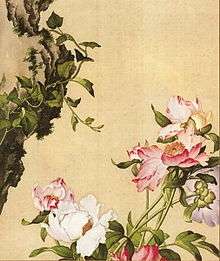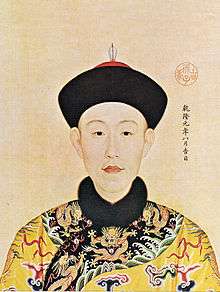Giuseppe Castiglione (Jesuit)
| Giuseppe Castiglione | |
|---|---|
 Linear perspective painting by Castiglione. (The Old Summer Palace museum collection) | |
| Born |
19 July 1688 Milan, Italy |
| Died |
17 July 1766 (aged 77) Beijing, China |
| Nationality | Italian |
| Known for | Painting and architecture |
Giuseppe Castiglione, S.J. (simplified Chinese: 郎世宁; traditional Chinese: 郎世寧; pinyin: Lángshìníng) (July 19, 1688 – July 17, 1766), was an Italian Jesuit lay brother who served as a missionary in China, where he became a painter at the imperial court of the Qianlong Emperor.
Early life
Born in Milan's San Marcellino district, in his early years Castiglione studied painting with Carlo Cornara of the renowned Bottega degli Stampatori painting studio. In 1709 he became a Jesuit. Although a Jesuit, he was never a priest. He was rather a lay brother.
Work in China
The Jesuits in China having asked for a painter to be sent to the imperial court in Beijing, Castiglione volunteered and was accepted. In 1710 on the way to Lisbon he passes through Coimbra where he is kept several years to decorate the chapel of St. Francis Borgia in the Church of the novitiate, today the New Cathedral of Coimbra, and painted a Circumcision of Jesus for the main altar of the same church.[1]
In 1715, Castiglione arrived in China as a missionary. While there, Castiglione took the name Lang Shining (郎世寧). His skill as an artist was appreciated by the Qianlong Emperor and Castiglione spent many years in the court painting various subjects, including the portraits of the emperor and empress.
Castiglione's work served as the subject for a series of "Battle Copper Prints" commissioned by the Emperor to commemorate his military campaigns. Small-scale copies of his paintings were shipped to Paris and rendered into engravings with etching before being returned to China. A series of sixteen prints by Castiglione and his contemporaries Jean-Denis Attiret, Ignatius Sichelbart and Jean-Damascène Sallusti were created in this way.[2]
Castiglione's style was a unique blend of European and Chinese compositional sensibility, technique and themes. Western style was adjusted to suit Chinese taste - strong shadows used in chiaroscuro techniques were unacceptable as the Qianlong Emperor thought that shadows looked like dirt, therefore when Castiglione painted the emperor, the intensity of the light was reduced so that there was no shadow on the face, and the features were distinct.[3]
In addition to his demonstrable skill as a painter, he was also in charge of designing the Western-Style Palaces in the imperial gardens of the Old Summer Palace. This prominent Jesuit artist, architect, and missionary died in Beijing.
Influences
Due to Castiglione's work Qing court paintings began to show a clear Western influence. Other European painters followed and a new school of painting was created that combined Chinese and Western methods. The influence of Western art on the Qing court paintings is particularly evident in the light, shade, perspective, as well as the priority given to recording contemporary events.[3]
In 2005, Castiglione became the subject of the television series Palace Artist in China, played by famed Canadian-Chinese actor Dashan (Mark Rowswell), and broadcast by China Central Television (CCTV).
Gallery
-

The Qianlong Emperor
-

The Qianlong Emperor chasing a deer on a hunting trip
-

The Pine, Hawk and Glossy Ganoderma
-

Qianlong collecting lingzhi
-

One of Giuseppe Castiglione's Afghan Four Steeds, features a horse named Chaoni'er (超洱骢, literally Exceeding Piebald).
-

Ayusi assailing the rebels with a lance
-

Followers in the Vase
See also
References
- ↑ http://www.monumentos.pt/Site/APP_PagesUser/SIPA.aspx?id=2809
- ↑ Castiglione, Giuseppe; Le Bas, Jacques-Philippe (1765). "Storming the Encampment at Gadan-Ola". World Digital Library (in French). Xinjiang, China. Retrieved 28 May 2013.
- 1 2 Yang Xin, Rihard M. Barnhart, Nie Chongzheng, James Cahill, Lang Shaojun, Wu Hung. Three Thousand Years of Chinese Paintings. Yale University Press. pp. 282–285. ISBN 978-0-300-07013-2.
External links
| Wikimedia Commons has media related to Giuseppe Castiglione. |
- Lang Shining and his Painting Gallery at China Online Museum
- National Palace Museum Taiwan
- Palace Artist on Mark Rowswell's website
- Qianlong and his imperial concubines by Giuseppe Castiglione
Bibliography
- Robert Loehr, Giuseppe Castiglione (1688–1766) pittore di corte di Ch’ien-Lun, imperatore della Cina (Rome: ISMEO, 1940).
- George Robert Loehr, “European Artists at the Chinese Court,” in The Westward Influence of the Chinese Arts from the 14th to the 18th Century, ed. William Watson, Colloquies on Art & Archaeology in Asia, no. 3 (London: Percival David Foundation, 1972): 333–42.
- Joseph Deheregne, Répertoire des Jésuites de Chine de 1552 à 1800 (Rome: Institutum Historicum S. I., 1973), 95.
- Willard Peterson, “Learning from Heaven: the introduction of Christianity and other Western ideas into late Ming China,” in The Cambridge History of China, ed. Denis Twitchett and Frederick W. Mote, 15 vols. (Cambridge: Cambridge Univ. Press, 1988), 8:789–839.
- Cécile Beurdeley and Michel Beurdeley, Giuseppe Castiglione: A Jesuit Painter at the Court of the Chinese Emperors (London: Lund Humphrey, 1972).
- Hongxing Zhang, ed., The Qianlong Emperor: Treasures from the Forbidden City (Edinburgh: NMS, 2002).
- Evelyn Rawski and Jessica Rawson, China: The Three Emperors 1662–1795 (London: Royal Academy of Arts, 2005).
- John W. O’Malley et al., eds., The Jesuits: Cultures, Sciences, and the Arts 1540–1773, (Toronto: Univ. of Toronto Press, 1999).
- Ho Wai-kam, ed., Eight Dynasties of Chinese Painting: The Collections of the Nelson Gallery-Atkins Museum, Kansas City, and the Cleveland Museum of Art (Bloomington: Indiana Univ. Press, 1980), 355.
- Memoria Postuma Fratris Josephi Castiglione, Bras. 28, ff. 92r–93v, Archivum Romanum Societatis Iesu (ARSI), Rome.
- Georg Pray, ed., Imposturae CCXVIII. in dissertatione R. P. Benedicto Cetto, Clerici Regularis e Scholis Piis de Sinensium Importuris Detectae et convulsae. Accedunt Epistolae Anecdotae R. P. Augustini e Comitibus Hallerstain ex China scriptae (Buda: Typis Regiae Universitatis, 1791).
- Marco Musillo, “La famille de Giuseppe Castiglione (1688–1766)”, (Paris: Thalia Edition, 2007).
- Marco Musillo, “Les peintures génoises de Giuseppe Castiglione”, (Paris: Thalia Edition, 2007).
- Michèle Pirazzoli-t’Serstevens, Giuseppe Castiglione 1688-1766: Peintre et architecte à la cour de Chine (Paris: Thalia Edition, 2007), 18–25.
- Marco Musillo, “Bridging Europe and China: The Professional Life of Giuseppe Castiglione (1688–1766)” tesi di dottorato (University of East Anglia, 2006).
- Marco Musillo: "Reconciling two careers: the Jesuit Memoir of Giuseppe Castiglione lay brother and Qing imperial painter" in Eighteenth-Century Studies, vol. 42, no. 1 (2008) Pp. 45–59.
- Antonio Franco, Synopsis Annalium Societatis Jesu in Lusitania ab anno 1540 usque ad annum 1725 (Lisbon: Real collegio das artes da Companhia de Jesus, 1760), 441; e Imagem da Virtude em o Noviciado da Companhia de Jesus do Real Collegio do Espirito Santo de Evora (Lisbon: Real collegio das artes da Companhia de Jesus, 1714), 57.
- Relazione scritta da Monsignor Vescovo di Pechino al P. Giuseppe Cerù, in ordine alla Publicazione de Decreti apostolici (1715), ms. 1630, ff. 146r–152v, f. 149r. Biblioteca Casanatense, Rome.
- Copie manoscritte di vari scritti del Servo di Dio Matteo Ripa (1874), Cina e Regni Adiacenti Miscellanea 16, f. 21r, 26 December 1715, APF, Roma.
- Yang Boda, “The Development of the Ch’ien-lung Painting Academy,” in Words and Images, ed. Alfreda Murck and Wen C.Fong (New York: Princeton Univ. Press, 1991), 333–56, 345.
- George Robert Loehr, “Giuseppe Castiglione,” Dizionario Biografico degli Italiani (Roma: Istituto della Enciclopedia Italiana, 1970), 22:92–94, 93.
- Father Jean Sylvain de Neu-vialle (Newielhe, 1696–1764) Relaçao da jornada, que fez ao Imperio da China, e sumamria noticia da embaixada, que deo na Corte de Pekim Em o primeiro de Mayo de 1753, o Senhor Francisco Xavier Assiz Pacheco e Sampayo (Lisbon: Officina dos Herd. De Antonio Pedrozo Galram, 1754), 8.
- Edward J. Malatesta and Gao Zhiyu, eds., Departed, yet Present. Zhalan the Oldest Christian Cemetery in Beijing (Macau and San Francisco: Instituto Cultural de Macau and Ricci Institute, 1995), 217.
- Lo-shu Fu, A Documentary Chronicle of Sino-Western Relations (1644–1820), 2 vols. (Tucson: Univ. of Arizona Press, 1966), 1:188–89.
- Ishida Mikinosuke, “A Biographical Study of Giuseppe Castiglione (Lang Shih ning) a Jesuit Painter in the Court of Peking under the Ch’ing Dynasty,” Memoirs of the Research Department of the Toyo Bunko, no. 19 (1960): 79–121, 88–90.
Lang Shining xiaozhuan (Short biography of Lang Shining) in "Gugong bowuyuan yuankan", n. 2, 1988, pp. 3–26, 91-95.
- Aimé -Martin, M. L. (ed.) Lettres édifiantes et curieuses concernant l'Asie, l'Afrique et l'Amérique, avec quelques relations nouvelles des missions, et des notes géographiques et historiques, Paris 1838-1843, vol. II,III,IV.
- Beurdeley, C. et M., Castiglione, peintre jesuite a la cour de Chine, Fribourg 1971.
- Chayet, A., Une description tibétaine de Yuanmingyuan, in Le "Yuanmingyuan". Jeux d'eau et palais européens du XVIIIe siecle a la cour de Chine, Paris 1987.
- Cheng, T. K., Chinese Nature Painting, in "Renditions", n. 9, spring 1978, pp. 5–29.
- Durand, A., Restitution des palais européens du Yuanmingyuan, in "Arts Asiatiques", vol. XLIII, 1988, pp. 123–133.
- Hou Jinlang- Pirazzoli, M., Les chasses d'automne de l'empereur Qianlong à Mulan, in "T'oung Pao", vol. LXV, 1-3, pp. 13–50.
- Hucker, C., A Dictionary of Official Titles in Imperial China, Stanford 1985.
- Jonathan, P.-Durant, A., La promenade occidentale de l'empereur Qianlong, in Le "Yuanmingyuan". Jeux d'eau et palais européens du XVIIIe siecle a la cour de Chine, Paris 1987, pp. 19–33.
- Ju Deyuan-Tian Jieyi-Ding Qiong, Qing gongtong huajia Lang Shining, in "Gugong bowuyuan yuankan", n. 2, 1988, pp. 27–28.
- Kao Mayching, M., China's Response to the West Art: 1898-1937, Ann Arbor, Mich. 1972.
- Lettres édifiantes et curieuses, écrites des Missions Etrangères, Nouvelle edition, Paris 1781, vol. XXII, XXIII, XXIV.
- Liu Pinsan, Huama he Lang Shining "Bajuntu" in "Gugong bowuyuan yuankan", n. 2, 1988, pp. 88–90.
- Nie Chongzheng, Lang Shining, Beijing 1984.
|
